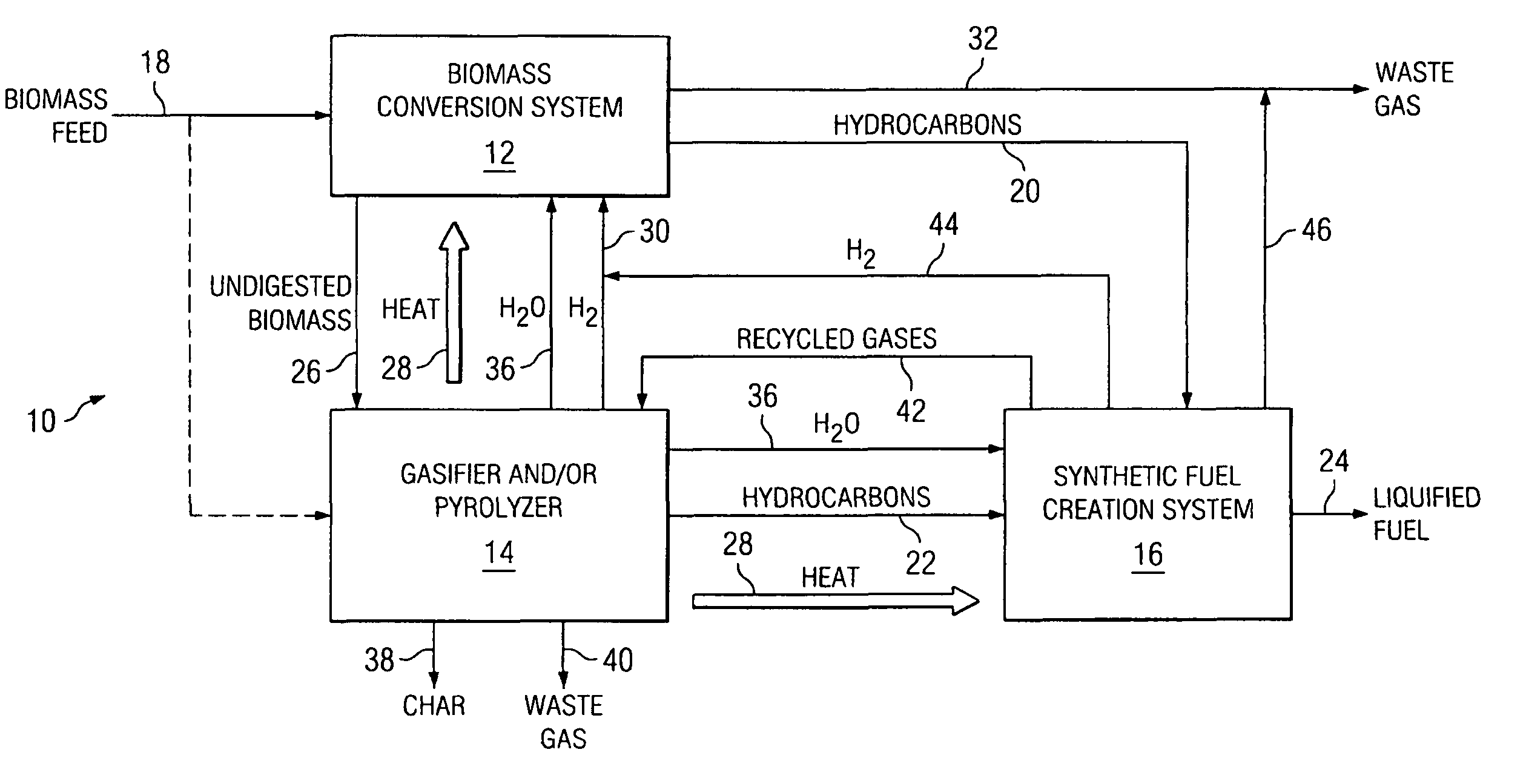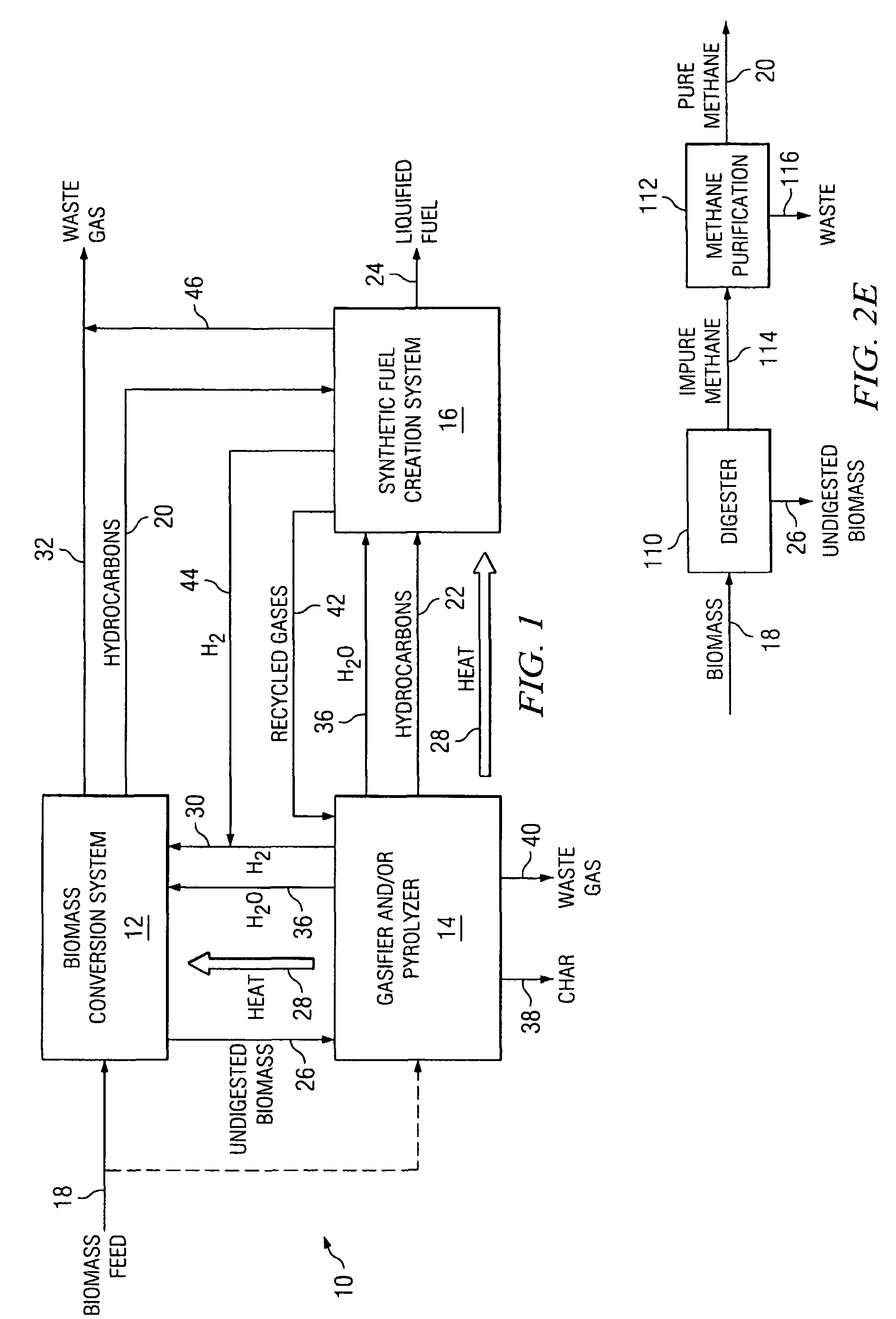Integrated biofuel production system
a biofuel and production system technology, applied in the field of biofuels, can solve the problems of increased air pollution, ethanol is also corrosive, alcohols also have a tendency to absorb water, etc., and achieve the effects of high energy density, enhanced conversion process efficiency, and high yield
- Summary
- Abstract
- Description
- Claims
- Application Information
AI Technical Summary
Benefits of technology
Problems solved by technology
Method used
Image
Examples
example 1
Conversion of Switchgrass to Gasoline using Fermentation to Carboxylate Salts, Pyrolysis, and Gas-to-Liquid Fuel Synthesis
[0096]One hundred tonnes of switchgrass (comprising approximately 70% holocellulose and 30% lignin) is mixed with 15 tonnes of slaked lime (Ca(OH)2)). After pretreatment is completed, it is allowed to ferment anaerobically in a lined pit with selected microorganisms and methanogen inhibitors for approximately 15 days at 55° C. in the presence of water and air. During the fermentation, the microbes selectively produce carboxylic acids which dissolve in the water and pass to the bottom of the pit where the dissolved acids are collected. The dissolved acids are neutralized with CaCO3 as they are collected to produce an aqueous broth of carboxylic acid salts. After four weeks of fermentation, approximately 42 tonnes of CaCO3 has been used to produce approximately 1000 tonnes of broth containing dissolved carboxylic acid salts. During the fermentation process, the 100...
example 2
Conversion of Manure to Gasoline using Anaerobic Digester, gasification, and Gas-to-Liquid Fuel Synthesis
[0100]One million, two hundred thousand liters of manure slurry from a 750-cow dairy farm are anaerobically digested by thermophilic methanogenic bacteria in a heated tank for approximately 15 days. During the course of the anaerobic digestion, approximately 1.6 Mft3 of biogas is produced. As the biogas is produced, it is scrubbed to remove H2S, and other contaminants, resulting in approximately 45,000 m3 (32 tonnes) of clean methane (CH4) which is compressed for storage. After digestion, approximately one million liters of liquid fertilizer is recovered and sold for field application. After removal of the liquid component, approximately 120 tonnes of wet digested solids remain. The digested solids are dried to produce approximately 20 tonnes of dry residual biomass.
[0101]Twenty tonnes of dry residual biomass is mixed with approximately 15 tonnes of lime. The mixture of lime and ...
example 3
Conversion of Switchgrass to Liquid Hydrocarbon Fuel Using Pyrolysis and Gas-to-Liquid Fuel Synthesis
[0103]FIG. 15 depicts the direct conversion of raw biomass to liquid hydrocarbon fuels using pyrolysis and a gas to liquid fuel conversion subsystem. One hundred tonnes of dried switchgrass is pulverized (micronized) resulting in 100 tonnes of dried, pulverized switchgrass with an average water content of 10%. The 100 tonnes of dried, pulverized switchgrass is fed into a pyrolysis reactor where the dried, pulverized switchgrass is flash pyrolyzed at approximately 500° C. to produce 76 tonnes of mixed hydrocarbon gasses and 14 tonnes of char. The char is separated from the hydrocarbon gasses and a small amount of vaporized pyrolysis oil with a cyclone, but the hot hydrocarbon gasses are not condensed to form pyrolysis oil.
[0104]The 76 tonnes of hot, mixed hydrocarbon gasses are fed into the thermal conversion stage of a gas-to-liquid fuel synthesis subsystem, along with 116 tonnes of ...
PUM
| Property | Measurement | Unit |
|---|---|---|
| temperature | aaaaa | aaaaa |
| temperature | aaaaa | aaaaa |
| temperatures | aaaaa | aaaaa |
Abstract
Description
Claims
Application Information
 Login to View More
Login to View More - R&D
- Intellectual Property
- Life Sciences
- Materials
- Tech Scout
- Unparalleled Data Quality
- Higher Quality Content
- 60% Fewer Hallucinations
Browse by: Latest US Patents, China's latest patents, Technical Efficacy Thesaurus, Application Domain, Technology Topic, Popular Technical Reports.
© 2025 PatSnap. All rights reserved.Legal|Privacy policy|Modern Slavery Act Transparency Statement|Sitemap|About US| Contact US: help@patsnap.com



